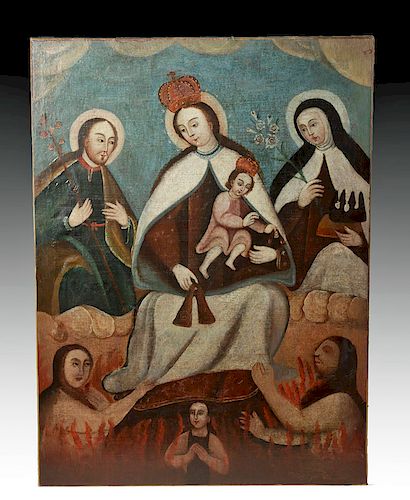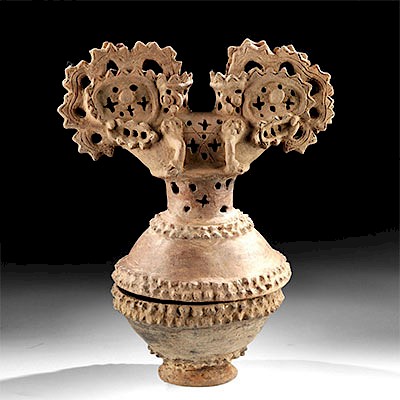19th C Mexican Painting - Mary, St John, St Teresa
Lot 171d
About Seller
Artemis Gallery
686 S Taylor Ave, Ste 106
Louisville, CO 80027
United States
Selling antiquities, ancient and ethnographic art online since 1993, Artemis Gallery specializes in Classical Antiquities (Egyptian, Greek, Roman, Near Eastern), Asian, Pre-Columbian, African / Tribal / Oceanographic art. Our extensive inventory includes pottery, stone, metal, wood, glass and textil...Read more
Estimate:
$3,000 - $4,500
Absentee vs Live bid
Two ways to bid:
- Leave a max absentee bid and the platform will bid on your behalf up to your maximum bid during the live auction.
- Bid live during the auction and your bids will be submitted real-time to the auctioneer.
Bid Increments
| Price | Bid Increment |
|---|---|
| $0 | $25 |
| $300 | $50 |
| $1,000 | $100 |
| $2,000 | $250 |
| $5,000 | $500 |
| $10,000 | $1,000 |
| $20,000 | $2,500 |
| $50,000 | $5,000 |
| $100,000 | $10,000 |
| $200,000 | $20,000 |
About Auction
By Artemis Gallery
Aug 22, 2019
Set Reminder
2019-08-22 10:00:00
2019-08-22 10:00:00
America/New_York
Bidsquare
Bidsquare : Fine Ancient | Asian | Ethnographic Art
https://www.bidsquare.com/auctions/artemis-gallery/fine-ancient-asian-ethnographic-art-4348
Featuring classical antiquities, ancient and ethnographic art from cultures encompassing the globe, plus fine art. Egyptian, Greek, Roman, Etruscan, Near Eastern, Asian, Pre-Columbian, Native American, African / Tribal, Oceanic, Spanish Colonial, Russian, Fine Art, so much more! Artemis Gallery info@artemisgallery.com
Featuring classical antiquities, ancient and ethnographic art from cultures encompassing the globe, plus fine art. Egyptian, Greek, Roman, Etruscan, Near Eastern, Asian, Pre-Columbian, Native American, African / Tribal, Oceanic, Spanish Colonial, Russian, Fine Art, so much more! Artemis Gallery info@artemisgallery.com
- Lot Description
Latin America, Mexico, ca. 19th century CE. A large painting on canvas depicting the Blessed Virgin Mary in her role as the patroness of the Carmelite Order or the Discalced Carmelite Order - also known as the Scapular of Our Lady of Mount Carmel or the Brown Scapular. N.S. de Carmen is presented in her role as the protectress, donning her traditional robes painted jewel tone red with golden stars and decorative trim. Both Our Lady of Mount Carmel and the Child hold scapulars that resemble the shield of the Carmelite Order, traditionally depicted as the cross on a mound with stars on either side (these are more stylized). Mary holds the Christ Child and is flanked by St. John of the Cross and St. Teresa of Avila, two of the most distinguished Carmelites revered as great mystics. Below are 3 souls in purgatory. A quaint painting in a somewhat naive style, both charming and richly symbolic. Size: 38.125" L x 28.125" W (96.8 cm x 71.4 cm)
The feast day of Our Lady of Mount Carmel associated with the Scapular is celebrated on July 16th. According to the Congregation for Divine Worship and the Discipline of the Sacraments; Directory on Popular Piety and the Liturgy. Principles and Guidelines. Vatican, 2001, the Brown Scapular is "an external sign of the filial relationship established between the Blessed Virgin Mary, Mother and Queen of Mount Carmel, and the faithful who entrust themselves totally to her protection, who have recourse to her maternal intercession, who are mindful of the primacy of the spiritual life and the need for prayer."
The scapular was traditionally a broad band of cloth worn over the shoulders, that fell below the knees toward the feet front and back as an apron. It is still worn as a component of the religious habit by a number of orders of monks and friars. Gradually the scapular was adapted for use by the laity, and became two small panels of brown cloth joined by strings and worn over the shoulders as a familiar Marian sacramental. Its popularity persisted because of its association with the salvation of souls.
Provenance: private Moore collection, Denver, Colorado, USA, acquired thirty years ago
All items legal to buy/sell under U.S. Statute covering cultural patrimony Code 2600, CHAPTER 14, and are guaranteed to be as described or your money back.
A Certificate of Authenticity will accompany all winning bids.
We ship worldwide and handle all shipping in-house for your convenience.
#122002Areas of restoration with visible signs on the verso of the canvas and some losses to peripheries. Pigments have darkened a bit with minor losses and areas of craquelure. The painting was put on newer stretchers with gallery tape rather than cross bars.Condition
- Shipping Info
-
All shipping is handled in-house for your convenience. Your invoice from Artemis Gallery will include shipping calculation instructions. If in doubt, please inquire BEFORE bidding for estimated shipping costs for individual items.
-
- Buyer's Premium



 EUR
EUR CAD
CAD AUD
AUD GBP
GBP MXN
MXN HKD
HKD CNY
CNY MYR
MYR SEK
SEK SGD
SGD CHF
CHF THB
THB

















